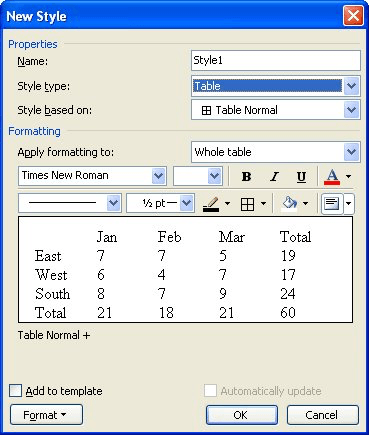Please Note: This article is written for users of the following Microsoft Word versions: 97, 2000, 2002, and 2003. If you are using a later version (Word 2007 or later), this tip may not work for you. For a version of this tip written specifically for later versions of Word, click here: Shading Table Rows.
Written by Allen Wyatt (last updated March 13, 2021)
This tip applies to Word 97, 2000, 2002, and 2003
In Excel it is possible to use conditional formatting to shade every other row (or every nth row) of a data table. You may want to accomplish the same task in Word, and the program provides several approaches you can take.
One approach is to use the AutoFormat capabilities of Word on your table. Follow these steps:

Figure 1. The AutoFormat dialog box.
Many of the AutoFormats provided for tables are "smart," meaning that they can adjust row shading even if you add new rows to the table. How is this done? Glad you asked; that leads to the second method of shading table rows—table styles.
Styles have been available in Word for years and years. One of the relatively recent additions to Word's style capabilities is styles for tables. You can define a table style that automatically applies shading to either the even or odd rows in a table. (This is how the Table AutoFormats do it.) Follow these steps:

Figure 2. The New Style dialog box.
You've now created a shading style for either odd or even rows. You can apply this style to the table, as desired. The formatting automatically adjusts as you change the number of rows in the table.
The solutions described so far work great if you want to apply formatting to every other row in a table, and provided you are using a version of Word that supports table formatting. They don't work so well if you want the formatting applied to every third, fourth, or fifth row or if you are using an older version of Word that doesn't include table formatting. In these instances it may be best to use a macro to do your formatting. The following is a good example of a macro that can apply shading to every third row in a table:
Sub ShadeRows()
Dim iRow As Integer
Dim iHeads As Integer
Dim iRowTtl As Integer
If Selection.Information(wdWithInTable) = True Then
iHeads = InputBox(prompt:="Number of heading rows?", _
Title:="Headings", Default:="1")
iRowTtl = Selection.Tables(1).Rows.Count - iHeads
For iRow = 1 To iRowTtl
If iRow Mod 3 = 0 Then
Selection.Tables(1).Rows(iRow + iHeads).Shading.Texture _
= wdTexture20Percent
Else
Selection.Tables(1).Rows(iRow + iHeads).Shading.Texture _
= wdTextureNone
End If
Next iRow
End If
End Sub
The macro asks how many header rows are in the table, and then adjusts the rows to which it applies shading. If the insertion point is not within a table when the macro is run, then nothing happens. You can also change the frequency of shading (for instance, from every third row to every fourth) by changing the Mod formula. Simply change the single line, in this manner:
If iRow Mod 4 = 0 Then
You can also change the amount of shading by changing the wdTexture20Percent constant to another, such as wdTexture5Percent, wdTexture10Percent, wdTexture25Percent, etc.
You should also understand that if you run the macro on a table where cells have been merged vertically, you may get unexpected results, if any. If you change the number of rows in a table, then you will need to run the macro again to reapply the shading.
Note:
WordTips is your source for cost-effective Microsoft Word training. (Microsoft Word is the most popular word processing software in the world.) This tip (5814) applies to Microsoft Word 97, 2000, 2002, and 2003. You can find a version of this tip for the ribbon interface of Word (Word 2007 and later) here: Shading Table Rows.

Create Custom Apps with VBA! Discover how to extend the capabilities of Office 365 applications with VBA programming. Written in clear terms and understandable language, the book includes systematic tutorials and contains both intermediate and advanced content for experienced VB developers. Designed to be comprehensive, the book addresses not just one Office application, but the entire Office suite. Check out Mastering VBA for Microsoft Office 365 today!
How to make the border on the last row on a page look right.
Discover MoreIndividual cells in a table can be aligned any way you desire. As pointed out here, just select the cell and apply the ...
Discover MoreWhen you insert a table into your document, it uses a standard-weight line around each cell in the table. If you want to ...
Discover MoreFREE SERVICE: Get tips like this every week in WordTips, a free productivity newsletter. Enter your address and click "Subscribe."
There are currently no comments for this tip. (Be the first to leave your comment—just use the simple form above!)
Got a version of Word that uses the menu interface (Word 97, Word 2000, Word 2002, or Word 2003)? This site is for you! If you use a later version of Word, visit our WordTips site focusing on the ribbon interface.
Visit the WordTips channel on YouTube
FREE SERVICE: Get tips like this every week in WordTips, a free productivity newsletter. Enter your address and click "Subscribe."
Copyright © 2026 Sharon Parq Associates, Inc.
Comments